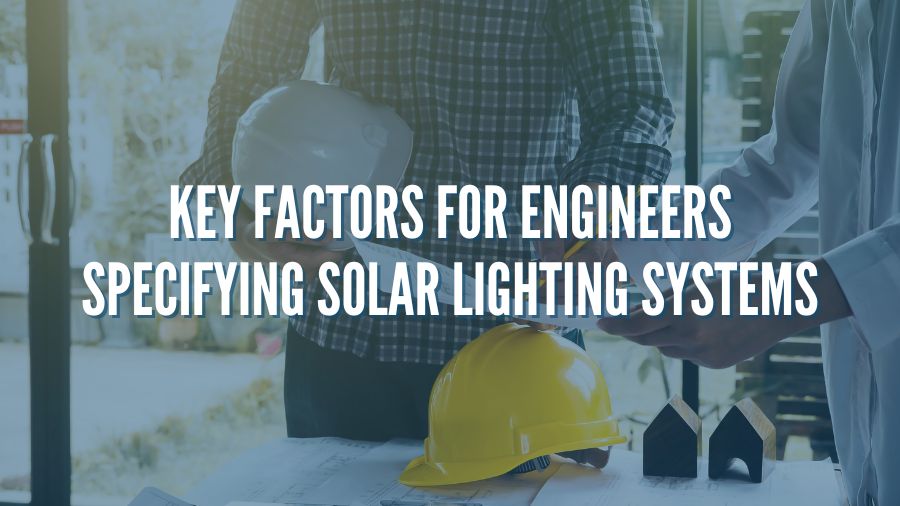


Incorporating solar lighting systems into engineering projects is a sustainable, energy-efficient solution that aligns with today's environmental goals. However, engineers must carefully specify the right components and design parameters to ensure the successful integration of solar lighting. This blog post will explore the key factors engineers should consider when specifying solar lighting systems.
Engineers must evaluate the site's location and sunlight availability before incorporating solar lighting systems. Latitude and longitude provide information on the sun's intensity and duration. Obstructions like structures or natural features can limit the amount of sunlight reaching the solar panels, reducing efficiency. Engineers must also consider shading from nearby structures and strategically position solar panels to minimize negative effects. This evaluation is crucial for achieving energy-efficient solutions that align with environmental goals.
Engineers must consider illuminance levels, lighting duration, and motion sensors when specifying solar lighting. Illuminance levels vary for different spaces. Engineers must determine the correct illuminance levels to select the appropriate lighting components. The lighting duration also varies depending on the project requirements. Engineers can design a solar lighting system that meets the project's specific needs by determining the required lighting duration. Motion sensors can be incorporated into the solar lighting system to optimize energy consumption. Engineers must conduct a thorough load analysis to ensure energy efficiency. The analysis involves calculating the energy requirements of each component in the system. By considering the specific lighting requirements and conducting a thorough load analysis, engineers can specify solar lighting systems that meet the project's needs while maximizing energy efficiency.
Properly sizing solar panels is crucial for an effective solar lighting system. Engineers calculate the required capacity based on lighting requirements, load analysis, and solar irradiance available in the project location. Panel angle and orientation also play a vital role in optimizing energy generation. Engineers can ensure an energy-efficient solution by accurately calculating the capacity and optimizing panel positioning.
Selecting the right batteries is crucial for a successful solar lighting system. Engineers must consider battery technology, lifespan, and capacity. Lithium-ion batteries offer high energy density, long cycle life, and high charge/discharge efficiency. Lead-acid batteries are cost-effective, durable, and can withstand harsh environmental conditions. Engineers must estimate energy requirements accurately and select batteries with sufficient capacity to avoid energy shortages. Proper maintenance and adherence to charging and discharging practices can extend the lifespan of both types of batteries.
Choose LED fixtures that are energy-efficient and compatible with solar systems for optimum performance. Ensure that the fixtures have high luminous efficacy and provide sufficient illumination. Look for durable fixtures with suitable Ingress protection (IP) ratings to withstand extreme outdoor conditions and reduce maintenance needs.
Intelligent lighting controls are key to saving energy in solar lighting. These controls include timers, dimmers, and motion sensors. Timers set light intervals, dimmers adjust brightness, and motion sensors activate lights when movement is detected. Using these controls, energy is used efficiently, making lighting systems more sustainable and effective.
Engineers need to consider various environmental factors when designing solar lighting systems. Extreme temperatures, humidity, exposure to rain, snow, wind, and dust can all affect the system's performance and lifespan. Therefore, selecting materials and components specifically designed for outdoor use with proven durability and high IP ratings is crucial. This approach ensures the system is resilient and reliable in any climate, reducing the need for frequent maintenance or replacements and contributing to its sustainability and effectiveness.
When designing and implementing a solar lighting system, it's crucial to comply with industry standards and local building codes. Adhering to these ensures safety, reliability, and effectiveness. Industry standards provide design, installation, and performance guidelines, while building codes outline regulations and requirements. Verifying certifications and warranties of components is also essential to ensure reliability and performance.
Design the solar lighting system with easy maintenance in mind. Use accessible components and standardized connectors to reduce downtime. Regular cleaning and inspections are necessary to ensure optimal performance. Include a maintenance schedule with periodic cleaning of solar panels and inspections for damage. This ensures timely repairs and prevents issues from affecting the system's overall performance.
As engineers, specifying solar lighting systems presents an opportunity to contribute to sustainable and environmentally conscious projects. By carefully considering these key factors—location, energy requirements, solar panel sizing, battery capacity, LED fixtures, controls, environmental conditions, compliance, and maintenance—you can design solar lighting solutions that meet project objectives and reduce long-term operating costs while minimizing environmental impact.
Looking for a comprehensive analysis and detailed overview? Look no further than our brand new whitepaper below. It delves even deeper into the topics discussed above, providing you with all the in-depth information you need.